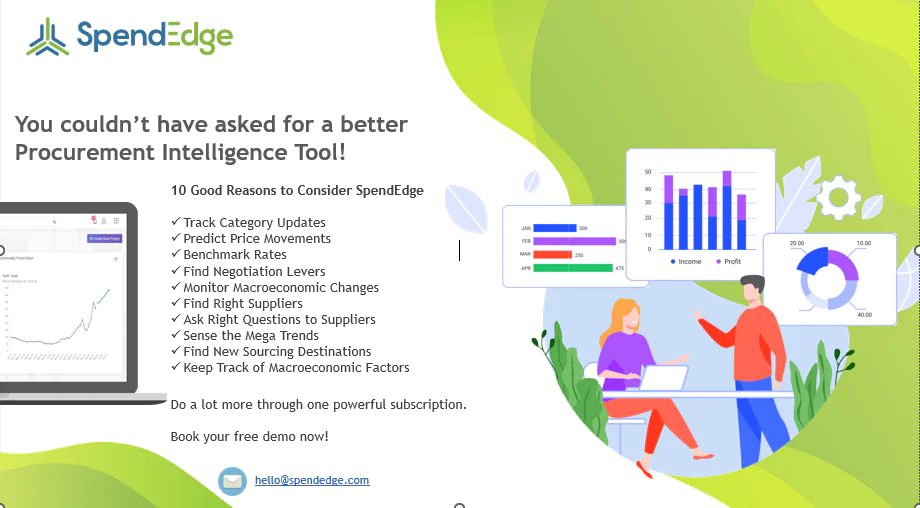| Client | Industry | Solution |
| Tire Manufacturer | Manufacturing, Transportation, Logistics, and Automotives | Streamline Supply Chain to Optimize Costs |
Background of this Tire Industry Analysis
Recently, SpendEdge assisted a leading player from the tire manufacturing industry that was aiming to reduce costs, evaluate its supply chain capabilities, compare efficiencies with competitors, and identify major spend areas across its supply chain and office locations.
A research study found that the global tire market size had reached 2,321.3 million units in 2022, and it is anticipated to grow at a CAGR of 2.81% till 2028. It was also found that various technological advancements are revolutionizing the transportation industry and green revolution with respect to EV/hybrid vehicles is leading to growing demand for tires. This, in turn, is providing players from the tire manufacturing industry tremendous opportunities.
The Business Challenge – Cost Optimization
A leading tire manufacturer wanted to effectively reduce costs across its supply chain. In line with this, the client wanted to evaluate its supply chain capabilities, compare its performance against competitors, and identify major areas of expenditure across its supply chain and different manufacturing locations to come up with effective strategies to reduce costs and enhance profitability.
Methodology Adopted to Address the Challenge
To cater to the specific requirements of the client, supply chain analysis experts at SpendEdge followed a comprehensive research methodology. This included primary and secondary research as well as qualitative and quantitative data collection. During this analytical engagement, supply chain mapping, supply chain risk analysis, and analysis of peers with respect to supply chain capabilities, efficiencies, as well as challenges and methodologies adopted to overcome these challenges were evaluated.
The analysis also enabled the client to discover major areas of spend across its supply chain and office locations and to effectively reduce costs based on specific nuances of each location.
Tire Industry Analysis
Factors such as a focus on fuel efficiency, increasing demand for low-rolling-resistance tires, stringent environmental regulations, and switching by consumers to eco-friendly tires with greater safety and durability along with reduced road noise, are expected to positively impact tire demand globally.
However, according to SpendEdge’s experts, the industry is facing challenges in terms of managing shorter order-to-delivery cycles, achieving reduced operating costs, and ensuring an efficient logistics network, which are acting as impediments to tire market growth. To address these issues and maintain their market respective positions in the market, major tire manufacturers are depending on supply chain analysis studies.
Strategies Suggested to Reduce Supply Chain-related Costs
Strategies for Cost Optimization
Demand Forecasting and Inventory Optimization
Supplier Collaboration and Negotiation
Implement Just-in-Time (JIT) Inventory System
Optimize the Supply Chain
Demand Forecasting and Inventory Optimization:
To improve inventory management, invest in data analytics and software tools that can analyze historical data and market trends. Accurate demand predictions can help avoid overstocking or understocking and reduce safety stock needs. Also, precise demand forecasts minimize storage costs and the risk of obsolescence.
Additionally, work closely with suppliers to shorten lead times and order tires closer to when they are needed, thereby reducing large inventory stockpiles.
Supplier Collaboration and Negotiation:
Establish long-term partnerships with key suppliers to negotiate favorable terms such as volume-based discounts and priority access to new models. Collaborate to identify cost-saving opportunities in the supply chain, optimize logistics, streamline orders, and reduce defects. Implement KPIs to evaluate supplier performance, encourage continuous improvement, and ensure optimal value for procurement spend.
Implement Just-in-Time (JIT) Inventory System:
Implement JIT inventory system as it reduces the need for large storage spaces, saving money and freeing up funds for other projects. It minimizes holding costs by keeping only the inventory needed for current demand. JIT also minimizes delays and bottlenecks and promotes a more flexible response to market changes and consumer demand.
Optimize the Supply Chain
An optimized supply chain offers several benefits. For instance, efficient global supply chains are crucial to remain competitive, especially with rapid advancements in tire technology. Also, a robust supply chain is essential for securing raw materials and technology. From raw material procurement to sales, minimizing inventory through product life cycle controls and ensuring timely supply are as crucial as product differentiation. To achieve this, the supply chains must function optimally, allowing manufacturers to adapt quickly to evolving needs and technological advances.
| Short-term benefits | Long-term benefits |
| Boost profits: Ensure on-time-in-full (OTIF) delivery. Enhance capacity planning by balancing constraints. Maximize resource use. Minimize setup times, inventory levels, and costs. Automate planning and scheduling. Improve process management. Achieve operational excellence and higher production quality at lower costs. | Improve visibility, enabling better investment decision making and more effective negotiations with suppliers. Assist in automating procurement and production based on real-time data. Help optimize production plans with accurate forecasts. Enable assignment of orders while considering factors such as customer location and transport mode. Effective product allocation and assessment of investment impacts on demand fulfilment and margins. Drive effective strategic decision making. |

To have a comprehensive understanding of our solutions at SpendEdge




